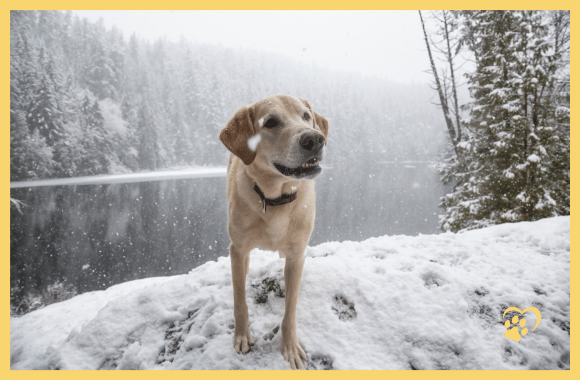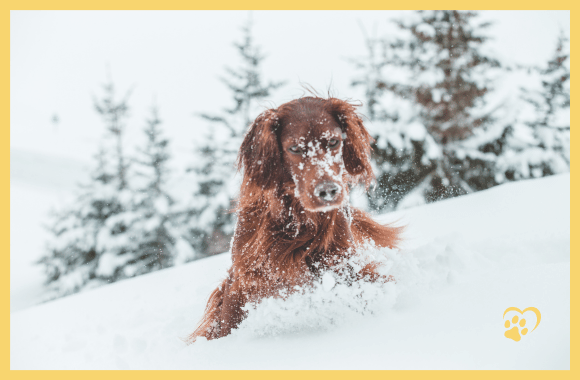In winter, when temperatures drop and snow falls, pets face particular challenges. Just like us humans, dogs can also suffer from winter conditions. Freezing cold, snow and road salt can pose real dangers. We show you how you can protect your dog from the dangers of winter so that he can get through the cold season safe and sound.
As a dog owner, we give you practical advice and tips on how you can best protect your four-legged friend from the dangers of winter. Starting with the risks your dog is exposed to in winter, through to specific measures you can take to keep him safe during the cold season.
Hypothermia
Especially in low temperatures and strong winds, hypothermia and frostbite can lead to serious health problems for your dog. It is important to recognize the signs early and take measures to avoid such situations.
The symptoms of hypothermia and frostbite in dogs can be subtle, so it's important to pay attention to changes in your dog's behavior and body temperature. Here are some signs that may indicate possible hypothermia or frostbite:
- Your dog is shaking strongly and uncontrollably.
- Paws, ears or the tip of the nose feel cold or are bluish in color.
- Your dog is lethargic and shows little interest in activities.
- The breathing rate is increased and your dog is breathing shallowly.
- Your dog's skin is pale or gray.
Prevention is the best medicine. Here are some simple steps you can take to prevent hypothermia and frostbite in your dog:
- Make sure your dog has enough fur and that it is well groomed to protect it from the cold.
- Avoid leaving your dog outside for long periods in extremely low temperatures.
- Use dog coats or sweaters to keep your dog warm.
- Protect your dog's paws from road salt and ice by using paw balm or dog shoes.
First aid
If you suspect that your dog is suffering from hypothermia or frostbite, you should act immediately:
- Take your dog to a warm place.
- Wrap him in warm blankets or towels so that his body temperature slowly rises again.
- Ask your vet for further instructions.
Your dog's wellbeing in winter is in your hands. With the right knowledge and the right precautions, you can ensure that your dog gets through the cold season well.
Danger from road salt
Road salt is often used to clear roads and sidewalks of ice and snow. However, it can be problematic for dogs as it can attack their paws and skin.
Road salt can irritate your dog's sensitive paws and even cause injuries. The chemical components of the salt can dry out the skin and cause cracks. Symptoms of road salt injuries include frequent licking of the paws, redness and irritation.
To protect your dog from the harmful effects of road salt, you should take the following measures:
- Rinse your dog's paws thoroughly with lukewarm water to remove the salt after a walk in the road salt area.
- Wear special dog shoes to protect your dog's paws from road salt and cold.
- Apply paw balm to moisturize the paws and protect them from irritation.
Read more about dog shoes: Why you should invest in dog shoes: Health and safety for your pet 

Icy ponds and bodies of water
Winter not only brings cold weather, but also dangers in the form of frozen ponds and bodies of water. Frozen ponds and bodies of water can pose a serious drowning hazard for dogs. Your dog can fall in if he steps on the seemingly solid ice.
Safety tips
To ensure your dog's safety near frozen water, you should take the following precautions:
- Keep your dog on a lead when walking near frozen water.
- Do not let your dog go onto the ice unless you are sure that it is safe to do so.
- If your dog falls into the water, do not try to get onto the ice yourself. Call for professional help immediately.
Snowball injuries to the paws
When snow melts between your dog's paw pads and freezes again, painful snowballs can form, which interfere with walking.
- Keep your dog's paws well groomed and trim the fur between the pads if necessary.
- Apply balm to prevent the snow from freezing in your dog's paws.
- Have your dog wear dog shoes to protect its paws from snow.

The right clothes for your dog
Choosing the right winter clothing for your dog can make a big difference when it comes to protecting them from the winter elements.
- Choosing the right winter clothing: When choosing winter clothing for your dog, you should pay attention to size, material and comfort. Make sure that the clothing keeps your dog warm and fits well without restricting his freedom of movement.
- Dressing: Dressing your dog requires patience and calmness. Show your dog that it is comfortable to wear the clothing and reward him with treats. Make sure that the clothing fits well and does not pinch.
Walks in the snow
Walks in the snow can be a wonderful experience for dogs and their owners, but require a certain amount of preparation so that your four-legged friend can enjoy the winter outings.
- Dogs must be kept on a lead: Even well-behaved dogs should be kept on a lead during winter walks. Icy surfaces and unknown dangers in the area can put your dog in dangerous situations.
- Avoid frozen bodies of water: Never enter frozen ponds or lakes. The ice can be treacherous and break, which can lead to life-threatening drowning.
- Beware of road salt: Keep your dog away from areas that are sprinkled with road salt, as it can irritate and crack your dog's paws. Watch out for symptoms such as increased paw licking and irritation.
- Dress appropriately: Dress warmly. Even if your dog has a coat, in very cold weather it may be advisable to dress him in additional winter clothing to protect him from the cold.
Good exercise and warming up
- Warm up before the walk: Start the walk slowly and let your dog warm up in the house before you go outside. This will help prevent muscle injuries in cold weather.
- Take breaks: Plan regular breaks during the walk so that your dog can rest and warm up. Offer him water, as sufficient hydration is also important in winter.
- Adapt the activity to the weather: Adjust the length and intensity of the walk to the weather conditions. In extremely cold weather, consider shorter walks and switch to indoor activities to keep your dog moving.
With these safety rules and the right preparation, you can ensure that your dog can enjoy a safe and healthy winter outdoors.
Nutrition and hydration in winter
Your dog's nutrition and hydration is particularly important in winter to ensure they have enough energy to survive the cold and get through the season well.
In winter, dogs may need more calories to maintain their body temperature. This is especially true for dogs that spend a lot of time outdoors or are physically active. Make sure you adjust your dog's food ration accordingly to cover its increased energy requirements.
If necessary, supplements can be useful to ensure that your dog gets all the nutrients it needs. This can be particularly important if your dog has special needs or is on a diet. Ask your vet if supplements are necessary and which ones are best for your dog.
Even though it is colder in winter, your dog's hydration should not be neglected. Dry air and colder temperatures can cause your dog to need more water to stay hydrated. Watch for signs of dehydration, such as increased panting and dry mucous membranes, and offer your dog fresh water regularly.
- Use heated water bowls outdoors to prevent the water from freezing.
- Make sure that drinking water is always accessible, even when walking outside.
- Make sure that your dog drinks enough water after intensive physical activity to compensate for fluid loss.
Proper nutrition and adequate hydration are key factors for your dog's health.
Your dog's behavior in winter
Cold weather and prolonged darkness can affect your dog's behavior, and it is important to recognize the signs of cold stress or discomfort. In addition, indoor activities and mental stimulation are important to keep your dog properly occupied during the cold season.
Your dog can show you that he is cold in various ways. Look out for the following signs:
- Trembling or shaking
- Frequent lifting of the paws
- Pulling in the tail between the hind legs
- Seek shelter from the wind and cold
- Persistent panting despite the cold
If you notice that your dog is showing signs of cold stress or discomfort, you should act quickly to protect him. Take him to a warm place, offer him a blanket and make sure he can warm up. If the symptoms worsen, consult your vet.
Ideas for games and activities in the house
In winter, it can be more difficult to keep your dog sufficiently occupied. Here are some ideas for indoor games and activities:
- Hide and seekHide treats in the house and let your dog search for them.
- Obedience trainingUse the time in the house to train your dog's obedience.
- Intelligence toysBuy or make intelligence toys that challenge your dog mentally.
- Obstacle course in the house: Set up a small obstacle course in the house for your dog to master. In addition to games and activities, there are other ways to keep your dog occupied:
- Chew toyOffer your dog safe chew toys.
- Puzzle boardsPuzzle boards are a great way to keep your dog mentally stimulated by making him find treats.
- Audio books or musicSome dogs react positively to calming music or audio books when you are not at home.
Indoor activities and mental stimulation are important to keep your dog happy and healthy. Pay attention to his needs so that he can enjoy the cold season.
Read more about this topic in our article on dog toys and ways to encourage your dog's intelligence:
- The different types of dog toys: discover the perfect toy for your dog

- Intelligence toys for dogs: creative ideas for mental challenges

- How do I develop my dog's intelligence?

Tips for a happy winter with your dog
Winter can be a wonderful time for you and your dog to have fun together, but there are also challenges to overcome.
Think about the needs of your four-legged friend by protecting him from the dangers of winter, making sure he is well fed and hydrated and keeping him busy indoors. With a little preparation and care, you can ensure that your dog enjoys winter to the full and stays healthy and happy.
